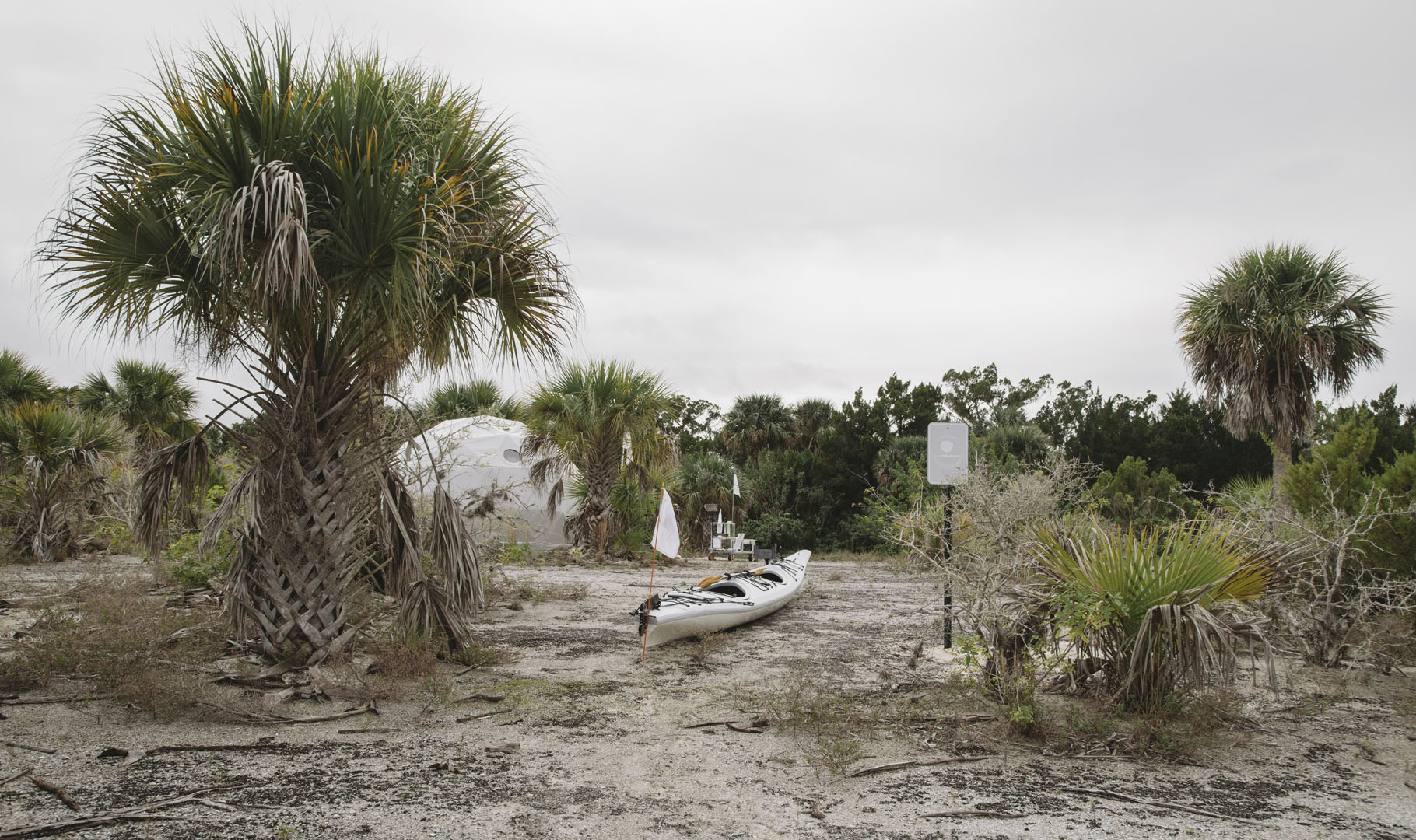

We developed an archive of research which critically and creatively explored a single “spoil island” in MINWR/KSC.
A public program and site specific installation on a manmade island in Kennedy Space Center & Merritt Island National Wildlife Refuge. Participants kayaked to the island where they were greeted by the artists and guided through the installation. The programs featured talks on the relationship between NASA and Fish and Wildlife Services, the formation of the Intracoastal Waterway, and the pre and post contact history of Indian River Lagoon.
+
An Exhibition at Atlantic Center for the Arts in New Smyrna Beach, Florida, presented a full-scale architectural installation, complete with tools, instruments, multimedia presentations, maps, and speculative site designs from the expedition.
Exhibit and public program presented two years of research and fieldwork into the ecology of the island, which was explored using photography, photogrammetry, 3D scanning, and 3D modeling. The project reasserts the linkages between art and science, examining how new territories have been rendered in part by naturalists who worked between artistic and scientific practice. The exhibit places the evidence gathered–such as taxonomies of spoil island wildlife that update natural histories and emergent topographies that catalogue “artificial histories”–within the context of broader questions of architecture’s role in conservation, exploration, and development.
Another Final Frontier exhibits work that combines artistic production with design and field research carried out on a spoil island that occupies both the Merritt Island National Wildlife Refuge and NASA’s Kennedy Space Center. Dredged for Intracoastal Waterway, the island is one of thousands that make up a linear archipelago that stretches from New York City to Brownsville, Texas. The center of the exhumed dirt, shell, and limestone feels—and looks—like the surface of the moon, while the island’s edges bristle with native and exotic species of plants and wildlife. A frontier between land and water as well as nature and human intervention, the island serves as a test case for alternative habitats on the margins of human habitation, not on far-flung moons or planets, but here on earth, in a place that is essentially hiding in plain sight, just offshore (but harboring mainland truths).
Given this context and as a mode of critical reflection, the project appropriates and modifies strategies developed by NASA to explore the lunar surface, turning those instruments and tools back onto the terrestrial and aquatic landscape of the spoil islands. The installation takes place on land built from dredged spoil. On one level, the exhibit creates another permutation of the spoil island expedition and camp and invites the public to experience architecture tuned to sites where nature is spoiled but thriving and artificial land is naturalized but constantly changing. At another level, the exhibit places the evidence gathered—such as taxonomies of spoil island wildlife that update natural histories and emergent topographies that catalogue “artificial histories”—in the context of broader questions of architecture’s role in conservation, exploration, and development. At a third level, with a speaker series and ready relocation to other critical sites in the archipelago, the exhibit speculates about the future of existing waste sites where techno-ecological hybrids make up another frontier of research and habitation.
More Info re public program:
Located on Grey Island itself, and with the help of Merritt Island National Wildlife Refuge and a local kayak company, a public program was created to engage with the local community of Titusville – a town which was once the epicenter of space travel and is only now making a comeback due to the resurgence of space travel. It offered a reconsideration of a familiar landscape while considering the complex, hidden layers of land usage.
Visitors were invited to kayak out to the island to witness a reconstruction of the artists’ original research site. We organized walking tours of the island by biologists at MINWR, heard stories of historic human occupation of KSC/MINWR from writer and architect Charlie Hailey, and heard talks by NASA biologists about land and wildlife management and the construction of new protective dunes in KSC. Speakers from the Marine Resources Council, local anthropologists, and historians with knowledge of the indigenous people who occupied the region pre-European contact such as the Ais people gave attendees a deeper historical context about the prior occupants and how their manmade “middens” – mounds of discarded shells – gave clues about their history and longevity in the area. They were, one might say, early forms of dredging.
Featuring writing by Charlie Hailey. Selected expedition Photography by Jessina Leonard
Exhibition + Program Photography by Han Seok You
Program film documentation Emily Bright.
Supported by Rhode Island School of Design, A Day Away Kayaks, NASA Kennedy Space Center, Merritt Island National Wildlife Refuge, and F.Domes, Indian River Anthropological Soceity, and Canaveral National Seashore.